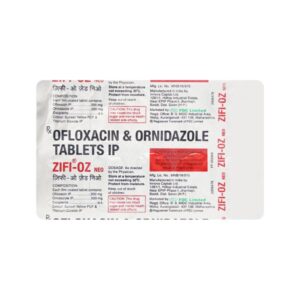ORNIDAZOLE + CEFIXIME
Ornidazole: Ornidazole is an antimicrobial and antiprotozoal drug that is used to treat various infections caused by bacteria and certain parasites. It is particularly effective against anaerobic bacteria, which are bacteria that can survive and thrive in environments with little or no oxygen.
Ornidazole works by interfering with the DNA replication process in these microorganisms, leading to their death. It enters the cell and forms unstable compounds with the DNA of the microorganism, which impairs its ability to replicate and divide.
The dosage of Ornidazole depends on the specific infection being treated. It is typically taken orally, either with food or on an empty stomach. The dose may vary from 500 mg to 2,000 mg per day and is usually divided into multiple doses. The duration of treatment also varies depending on the infection and its severity. It is important to follow the prescribed dosage and treatment duration provided by a healthcare professional.
Like any medication, Ornidazole can cause side effects. Common side effects include nausea, vomiting, headache, dizziness, and a metallic taste in the mouth. These side effects are usually mild and temporary, but if they persist or become bothersome, it is recommended to consult a healthcare professional. Rare but more serious side effects can include allergic reactions, seizures, and blood disorders. If any of these occur, immediate medical attention should be sought.
It is essential to inform the healthcare provider about any existing medical conditions, allergies, or medications being taken before starting treatment with Ornidazole, as it may interact with certain drugs or exacerbate underlying health conditions.
Overall, Ornidazole is a potent antimicrobial and antiprotozoal drug used to treat various infections caused by bacteria and parasites. Its mechanism of action involves interfering with DNA replication in these microorganisms, ultimately leading to their destruction. However, like any medication, it can cause side effects, and proper medical guidance should be followed during its use.
Cefixime: Cefixime is an antibiotic medication used to treat various bacterial infections. It belongs to the class of drugs known as cephalosporins and is primarily used to treat respiratory tract infections such as bronchitis, pneumonia, and tonsillitis, as well as urinary tract infections and ear infections.
The mechanism of action of cefixime involves inhibiting the synthesis of bacterial cell walls. It does this by binding to specific proteins called penicillin-binding proteins (PBPs) which are involved in the cross-linking of bacterial cell walls. By inhibiting PBPs, cefixime prevents the formation of a strong and protective cell wall, ultimately leading to the destruction of the bacteria.
The recommended dose of cefixime can vary depending on the specific infection being treated, the severity of the infection, and the patient’s age and overall health. Typically, the usual adult dose for most infections is 400 mg once daily or divided into two doses of 200 mg every 12 hours. For pediatric patients, the dose is usually based on their weight.
As with any medication, cefixime can cause side effects. Common side effects may include diarrhea, nausea, vomiting, stomach pain, headache, and mild rash. Less common but more serious side effects can include severe skin reactions, allergic reactions, and the development of antibiotic-resistant infections. It is important to contact a healthcare professional if any severe or concerning side effects occur.
It is worth noting that cefixime should only be used to treat bacterial infections and is not effective against viral infections such as the common cold or the flu. Additionally, it is important to complete the full course of treatment as prescribed to ensure the complete eradication of the infection and to prevent the development of antibiotic resistance.

